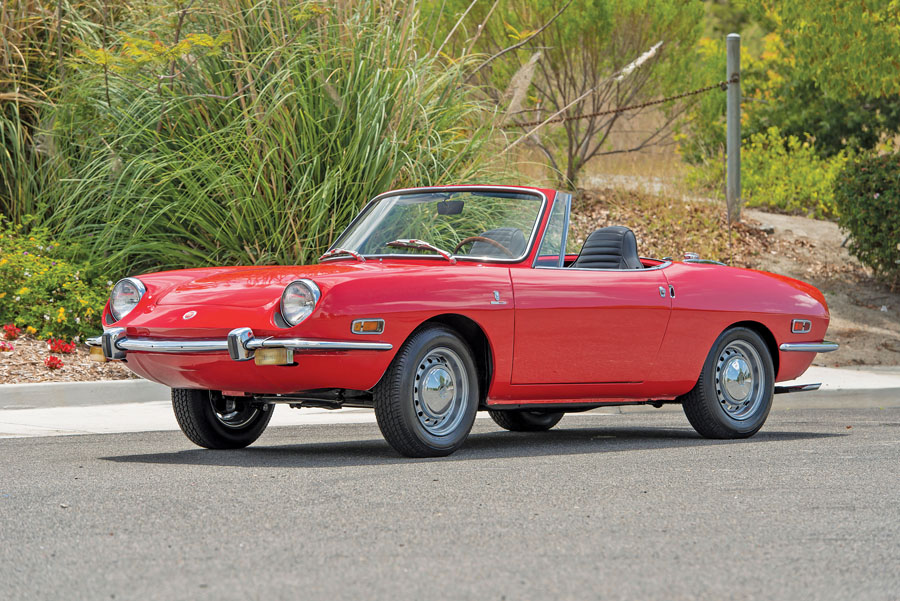
From the beginning, the Fiat 850 Spider has been overshadowed by its big sister, the 124 Spider. The 124 was prettier, more powerful and arranged as a proper sports car with the engine in front and the drive wheels in back. In contrast, the 850 Spider had its engine in the back. Although the little Fiat still pushed from the rear wheels, it never pushed very hard.
The Fiat 850 was developed in the early 1960s from the same underpinnings that drove the Fiat 500 and 600. The original engine displaced 843 cc and was rated at 52 horsepower and 46 pound-feet of torque. The transaxle was a Porsche design with four synchronized gears. The Spider shared this driveline with related 850 coupe, sedan and delivery van models, but it received front disc brakes.
A tricky emissions fix
After three years in Europe, the 850 Spider first came to America in 1967. As a mid-year arrival, just a few made it over before Fiat realized that the cars would have trouble meeting U.S. emissions standards.
Fiat also realized that engines under 50 cubic inches displacement were exempt from U.S. emissions, so they reduced the bore by 1 mm, which cut the displacement to 817 cc (or 49.9 cubic inches). To make up for the displacement loss, Fiat bumped the compression to 10:1, yielding about the same horsepower and torque figures as the European model.
Performance on the 850 was always uninspiring, especially in the horsepower-happy era of the late 1960s. Weighing in at a rather hefty 1,600 pounds, the little car took 20 seconds to make it to 60 mph and absolutely topped out at 90 mph. A removable metal hard top was available in addition to the standard convertible top, which may have improved aerodynamics a little, but just a little.
The 1968 and 1969 model years came with the 817 cc engine. For 1970 and 1971, Fiat enlarged both bore and stroke, raised the displacement to 903 cc and changed the name to the 850 Sport Spider. The new engine was rated at 58 horsepower and 47.7 pound-feet of torque but failed to improve 0–60 or top speed performance.
A special Racer model with a fixed hard top was made in 1970 and 1971. While the drivetrain was identical to the Spider, this model achieved a 0–60 time of 16.1 seconds and a top speed of 93 mph. The Racer model came at a $300 premium over the Spider.
In 1972, the U.S. change to SAE Net horsepower dropped the official engine rating to 48 horsepower and 45 pound-feet of torque, but nothing changed materially under the hood. Adding injury to the insult, the DOT burdened the 1972 models with a set of big, ugly bumpers. Fiat announced the follow-on X1/9 sports car in 1973, and that was the end of the 850 Spider.
Low price, high sales
The price of a new 850 in 1967 was about $2,000, compared with $3,000 for a 124 Spider, or $4,000 for an Alfa Romeo Duetto or a small-block Corvette. By 1973, the price of an 850 had risen only to about $2,700. Because of that, Fiat sold about 20,000 of the little Spiders each year.
In all, more than 124,000 Spiders were sold in America. So for a while there were plenty of 850 Spiders around, which kept prices low. Then poor reliability and an impressive tendency to rust continued to keep prices down. For a time, there were active clubs and enthusiasts with boneyards full of parts cars, but even those have now dwindled.
Good cars or fright pigs
What’s left on the market has bifurcated into two groups — cars that have been maintained or restored to very good to excellent condition, and fright pigs so derelict as to be less than worthless. There aren’t many left between those two extremes.
That’s important, because with an 850 Spider, you don’t want less than the best. Among the parts that have become nearly impossible to find are replacement body panels.
Rust is endemic in these cars, and fixing it will likely require fabrication because it will be even harder to find a cheap donor car that has not rusted away in the same places. Engine and other hard parts will be equally difficult to find.
Find a good one
Prices for 850 Spiders have topped $16,000 occasionally, but I’m going to say those buyers got drunk and paid too much. You can find plenty of good examples selling for four figures, such as the 1971 Fiat 850 Sport Spider (Lot 1050) that sold for $8,250 at Auctions America’s California sale on July 17, 2015.
It’s a good idea to start your search in the remaining 850 Spider enthusiast community. There are some good cars out there. As a bonus, you’ll probably get a much-needed garage full of spare parts and body panels with a private sale.
The bottom line is that there are very good reasons for the Fiat 850 Spider to remain affordable, but a good one will hold its value at this point.
If you can find one of the 850 Racer models, so much the better. Future prospects for appreciation are not great with any 850 variant, but you will get a fun car that is sure to spark more than a few conversations. Just choose wisely. ♦
